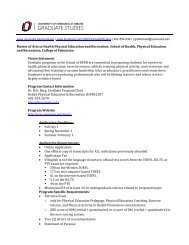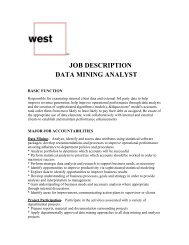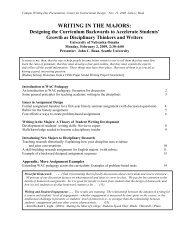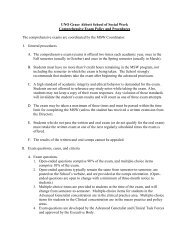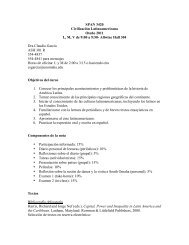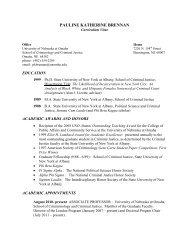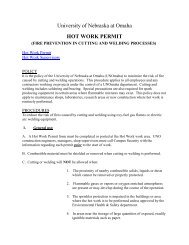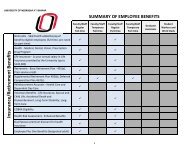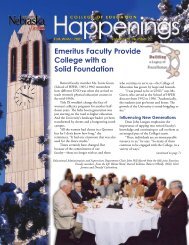The Role of the Endocrine System in Baboon Maternal Behavior
The Role of the Endocrine System in Baboon Maternal Behavior
The Role of the Endocrine System in Baboon Maternal Behavior
You also want an ePaper? Increase the reach of your titles
YUMPU automatically turns print PDFs into web optimized ePapers that Google loves.
M. Bardi et al BIOL PSYCHIATRY 2004;55:724–732 727<br />
<strong>the</strong> orig<strong>in</strong>al variables (Manly 1994). <strong>The</strong> percentage <strong>of</strong> variance<br />
expla<strong>in</strong>ed by new variables gives an idea <strong>of</strong> how much <strong>the</strong>y<br />
reflect <strong>the</strong> variation expressed <strong>in</strong> <strong>the</strong> orig<strong>in</strong>al data set. Because<br />
<strong>the</strong>re is an overlap <strong>of</strong> variance expla<strong>in</strong>ed between <strong>the</strong> right and<br />
left set <strong>of</strong> canonical correlation, redundancy is calculated toge<strong>the</strong>r<br />
with <strong>the</strong> percentage <strong>of</strong> <strong>the</strong> variance expla<strong>in</strong>ed by <strong>the</strong> new<br />
variables.<br />
Because we used statistics requir<strong>in</strong>g mult<strong>in</strong>ormal distributions,<br />
orig<strong>in</strong>al data were transformed by square-root transformation<br />
when <strong>the</strong>y were not normally distributed. It has been<br />
demonstrated that temperature affects frequency and duration <strong>of</strong><br />
<strong>the</strong>se behaviors <strong>in</strong> <strong>the</strong> colony under study (Brent et al 2003), thus<br />
orig<strong>in</strong>al contact-related behaviors (ventro–ventral contact, o<strong>the</strong>r<br />
contact, proximity, huddle) were also corrected by regress<strong>in</strong>g<br />
<strong>the</strong>m with <strong>the</strong> daily temperature recorded at <strong>the</strong> time <strong>of</strong> observation.<br />
All analyses were two-tailed. Data elaboration was carried out<br />
us<strong>in</strong>g <strong>the</strong> Statistica package (Stats<strong>of</strong>t 1998).<br />
Results<br />
Table 2. Eigenvalues, Contribution Rates, and Matrix <strong>of</strong> Correlation Between <strong>the</strong> Seventeen <strong>Maternal</strong> <strong>Behavior</strong><br />
Variables and <strong>the</strong> Four Indices Extracted by Pr<strong>in</strong>cipal Component Analysis<br />
<strong>Behavior</strong>al Unit<br />
Time <strong>in</strong><br />
Contact<br />
<strong>Maternal</strong><br />
Affiliative<br />
Pr<strong>in</strong>cipal component analysis <strong>in</strong>dicated that four groups <strong>of</strong><br />
maternal behavior variables were highly correlated (Table 2).<br />
<strong>The</strong> total variance expla<strong>in</strong>ed by <strong>the</strong> four components was modest<br />
(about 40%), and <strong>the</strong>refore we decided to <strong>in</strong>clude <strong>in</strong> each<br />
component <strong>the</strong> behavioral units that showed <strong>the</strong> highest correlation,<br />
<strong>in</strong>clud<strong>in</strong>g not significant and rare behaviors, to avoid<br />
los<strong>in</strong>g too much <strong>in</strong>formation. <strong>The</strong> first group was positively<br />
correlated with <strong>the</strong> amount <strong>of</strong> time spent <strong>in</strong> contact between<br />
mo<strong>the</strong>rs and <strong>in</strong>fants and <strong>in</strong>versely correlated with <strong>the</strong> number <strong>of</strong><br />
contacts broken by <strong>the</strong> mo<strong>the</strong>r and <strong>the</strong> time spent away from her,<br />
both with<strong>in</strong> and outside <strong>the</strong> mo<strong>the</strong>rs’ arms reach. <strong>The</strong>refore, we<br />
calculated <strong>the</strong> percentage <strong>of</strong> total time spent <strong>in</strong> contact between<br />
mo<strong>the</strong>rs and <strong>in</strong>fants and <strong>in</strong>cluded it as <strong>the</strong> first behavioral<br />
category (termed “time <strong>in</strong> contact”). <strong>The</strong> second group was<br />
<strong>Behavior</strong>al Categories<br />
<strong>Maternal</strong><br />
Ma<strong>in</strong>tenance<br />
<strong>of</strong> Contact<br />
<strong>Maternal</strong><br />
Stress<br />
Mean Values<br />
Ventral Contact .866 .059 .005 .214 46.1 6.1<br />
Mo<strong>the</strong>r Break .728 .210 .200 .313 2.0 1.4<br />
With<strong>in</strong> Arm’s Reach .876 .038 .014 .092 2.9 1.8<br />
Away Arm’s Reach .679 .062 .371 .219 3.1 2.9<br />
Enlist to Cl<strong>in</strong>g .078 .046 .686 .209 .3 .1<br />
Restra<strong>in</strong> .083 .117 .711 .060 .9 .6<br />
Retrieve .441 .295 .561 .229 .2 .1<br />
Detach .120 .722 .148 .156 .1 .1<br />
Watch .147 .484 .025 .209 2.0 .8<br />
Groom<strong>in</strong>g .119 .636 .034 .107 4.0 3.0<br />
Manipulate .125 .790 .067 .271 .4 .3<br />
Huddle .215 .301 .056 .105 1.0 .9<br />
Lipsmack .082 .099 .148 .103 .1 .1<br />
Startle .109 .037 .245 .5031 6.4 5.5<br />
Brow Wipe .060 .072 .353 .112 1.1 .7<br />
Muzzle Wipe .245 .031 .210 .674 1.8 1.1<br />
Scratch .100 .019 .186 .750 6.9 4.3<br />
Eigenvalues 3.02 2.14 1.75 1.60<br />
Variance Expla<strong>in</strong>ed (%) 17.78 12.57 10.32 9.40<br />
<strong>The</strong> coefficients <strong>in</strong> each column <strong>of</strong> <strong>the</strong> matrix <strong>of</strong> correlation (coefficients <strong>of</strong> eigenvectors) <strong>in</strong>dicate how much<br />
weight is assigned to each <strong>in</strong>dex. Mean values are expressed <strong>in</strong> m<strong>in</strong>/hour.<br />
highly correlated with watch, groom<strong>in</strong>g, manipulate, detach,<br />
and, <strong>in</strong> part, with huddle. All <strong>the</strong>se variables <strong>in</strong>dicate affiliative<br />
<strong>in</strong>teractions directed from <strong>the</strong> mo<strong>the</strong>rs to <strong>the</strong> <strong>in</strong>fants, and we<br />
<strong>the</strong>refore calculated a second category <strong>in</strong>clud<strong>in</strong>g <strong>the</strong> duration <strong>of</strong><br />
all <strong>the</strong>se behaviors and called it maternal affiliative. We <strong>in</strong>cluded<br />
lipsmack <strong>in</strong> this category even though it was not correlated with<br />
<strong>the</strong> o<strong>the</strong>r variables because <strong>the</strong> behavior pattern represents a<br />
common affiliative <strong>in</strong>teraction <strong>in</strong> baboons. <strong>The</strong> third group<br />
showed high correlation with enlist to cl<strong>in</strong>g, restra<strong>in</strong>, and retrieve<br />
and was <strong>the</strong>refore called “maternal ma<strong>in</strong>tenance <strong>of</strong> contact”; we<br />
<strong>in</strong>cluded <strong>the</strong> duration <strong>of</strong> <strong>the</strong>se three variables <strong>in</strong> this category.<br />
<strong>The</strong> f<strong>in</strong>al group, maternal stress, was highly correlated with<br />
scratch, startle, and muzzle wipe. Brow wipe was also <strong>in</strong>cluded<br />
<strong>in</strong> this category because <strong>of</strong> its aff<strong>in</strong>ity with <strong>the</strong> o<strong>the</strong>r variables. In<br />
most primate species, behaviors such as scratch and o<strong>the</strong>r<br />
displacement activities, such as brow wipe, muzzle wipe, and<br />
self-groom<strong>in</strong>g, have been shown to be l<strong>in</strong>ked to anxiety and<br />
stress (Brent et al 2002; Maestripieri 1993), <strong>the</strong>refore those<br />
behaviors were selected for <strong>the</strong> maternal stress category.<br />
After choos<strong>in</strong>g <strong>the</strong> four behavioral categories, we calculated<br />
<strong>the</strong> association between <strong>the</strong> behavioral set and <strong>the</strong> endocr<strong>in</strong>e set,<br />
composed from <strong>the</strong> <strong>in</strong>dividual average prepartum and postpartum<br />
levels <strong>of</strong> E 1C, PdG, and cortisol, us<strong>in</strong>g canonical correlation<br />
analysis. <strong>The</strong> correlation matrix between <strong>the</strong> behavioral data set<br />
(time <strong>in</strong> contact, maternal ma<strong>in</strong>tenance <strong>of</strong> contact, maternal<br />
affiliative, and maternal stress) and <strong>the</strong> endocr<strong>in</strong>e data set<br />
(prepartum and postpartum E 1C, PdG, and cortisol levels) is<br />
shown <strong>in</strong> Table 3. Univariate significant associations (p .05)<br />
were found among maternal stress and prepartum PdG (r .24;<br />
Figure 1), postpartum PdG (r .22; Figure 2), and postpartum<br />
cortisol (r .30; Figure 3), and between maternal affiliative<br />
behaviors and prepartum cortisol (r .25; Figure 4). Univariate<br />
trends for associations (p .1) were found between maternal<br />
ma<strong>in</strong>tenance <strong>of</strong> contact and prepartum cortisol (r .17) and<br />
www.elsevier.com/locate/biopsych




